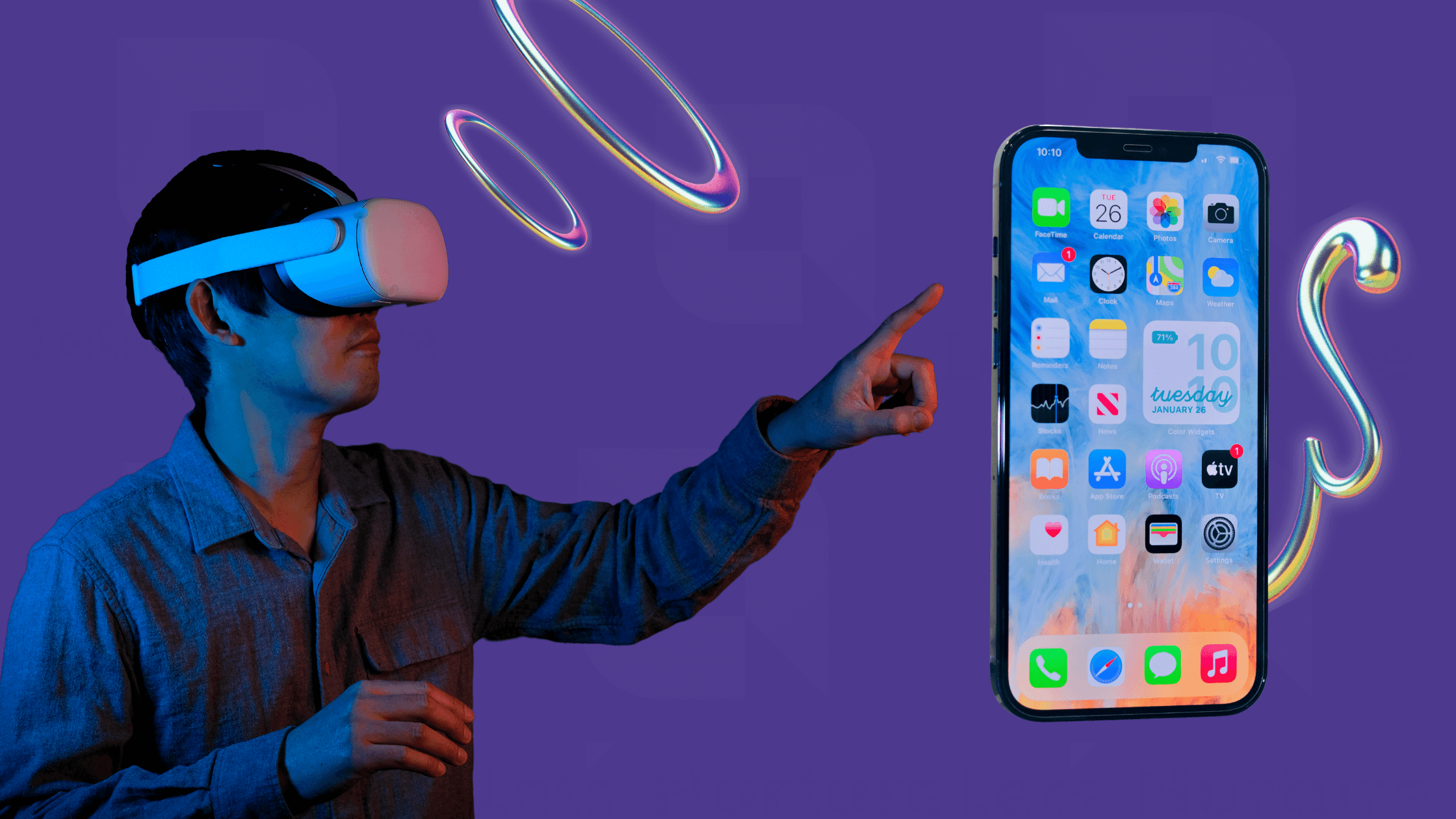- Tech Services

Concept Development
- Industry
- Emerging Tech
- Generative AI Hub
- Blog
- Contact Us

What is haptics? How can we implement in in AR based mobile App? What are Haptics Use cases?
In Lets Nurture
08
Dec. 23497
VIEWSWhat is haptics?
Haptics refers to the use of touch feedback technology to simulate the experience of interacting with virtual objects in a physical way. It involves creating a tactile response, such as vibrations, motions, or forces, that a user can feel, typically in response to certain actions or events in a digital environment. This technology is often used in various applications, including:
- Virtual Reality (VR) and Augmented Reality (AR): In VR and AR systems, haptic feedback enhances the immersive experience by providing physical sensations that correspond to virtual interactions, like feeling the recoil of a virtual gun or the resistance of a virtual object.
- Gaming: Gaming controllers often use haptic feedback to increase immersion, such as vibrating in specific patterns to simulate in-game events like explosions or collisions.
- Mobile Devices: Smartphones and tablets use haptic feedback to simulate physical button presses or to provide tactile responses to touch inputs.
- Wearable Devices: Smartwatches and fitness trackers use haptic alerts for notifications or feedback during activities.
- Robotics and Teleoperation: In robotics, haptics enables operators to feel what the robot feels, enhancing control and precision in tasks like surgery or handling hazardous materials.
- Automotive: Modern cars use haptic feedback in their touchscreens and controls to provide drivers with tactile responses, enhancing usability and safety.
Haptic technology aims to add a sense of touch to digital interactions, making them more realistic and intuitive. Advances in this field are continuously evolving, offering more sophisticated and realistic experiences in various applications.
10 Tips for Introducing Haptics in Your AR-Based Mobile Application
Augmented Reality (AR) has revolutionized the way users interact with apps, blending digital content into the real world. Integrating haptic feedback into AR applications can significantly enhance user experience by adding a tactile dimension. Here are 10 tips for successfully incorporating haptics into your AR mobile application.
1. Understand the Basics of Haptic Technology
Before diving in, familiarize yourself with what haptics is and how it works. Haptics in AR involves creating touch-based feedback to simulate real-life sensations, making interactions more immersive.
2. Define the Purpose of Haptics in Your App
Determine why you want to include haptic feedback. Is it to enhance realism, provide navigation cues, or improve user engagement? Clear objectives will guide your design decisions.
3. Know Your Hardware Limitations
Haptic feedback depends on the device’s capabilities. Most smartphones have basic vibration features, but newer models might offer more advanced haptic capabilities. Understand these limitations and capabilities to design effectively.
4. Prioritize User Experience
The user’s comfort and experience should be at the forefront. Haptic feedback should feel natural and intuitive, not disruptive or overwhelming.
5. Use Haptics to Enhance Realism
In AR, haptics can be used to mimic real-world interactions. For instance, simulating the feeling of raindrops or the vibration of a tool can greatly enhance realism.
6. Integrate Haptics with Visual and Audio Elements
Combine haptic feedback with visual and audio cues for a cohesive experience. When all these elements work in harmony, they create a more immersive and believable AR environment.
7. Keep Haptic Feedback Contextual and Meaningful
Ensure that the haptic responses are relevant to the actions and context within the app. Random or irrelevant haptic effects can confuse users or detract from the experience.
8. Test for Comfort and Accessibility
Regularly test your app with real users to ensure the haptic feedback is comfortable and not causing fatigue or discomfort. Consider accessibility for users who might be sensitive to such feedback.
9. Optimize for Battery Life
Haptic effects can be battery-intensive. Optimize your haptic feedback to be effective without draining the device’s battery quickly.
10. Stay Updated on Haptic Technology Trends
The field of haptics is rapidly evolving. Stay informed about the latest developments and consider how emerging technologies can enhance your AR app.
Incorporating haptic feedback into AR apps can transform user experiences, making them more engaging, interactive, and realistic. By following these tips, you can effectively integrate haptics into your AR-based mobile application and set a new standard in immersive user experiences.
Here are some innovative use cases and ideas where haptics can significantly enhance user experience in AR-based mobile applications:
1. Educational Apps
- Virtual Labs: Haptics can simulate the tactile experience of laboratory experiments, allowing students to feel textures and resistance as if they were handling actual lab equipment.
- Historical Explorations: Users exploring historical sites in AR can feel the texture of ancient artifacts or the roughness of old architecture, making history more tangible.
2. Gaming
- Adventure and Puzzle Games: Incorporate haptic feedback for interactions like opening a treasure chest or solving a puzzle, enhancing the sense of achievement and discovery.
- Sports Games: Simulate the sensation of hitting a ball or the impact of a tackle, adding realism to sports simulations.
3. E-Commerce and Retail
- Virtual Try-On: Enable shoppers to feel the texture of fabrics or the weight of items in virtual fitting rooms.
- Product Demonstrations: Simulate the feel of products, like the click of a camera button or the smoothness of a watch band, to aid in online shopping decisions.
4. Healthcare and Wellness
- Physical Therapy: Use haptic feedback to guide patients through exercises, providing gentle vibrations as cues for movement or posture corrections.
- Mental Wellness: Create calming experiences, like the sensation of a gentle breeze or a soft touch, to aid in relaxation and stress relief.
5. Travel and Tourism
- Virtual Tours: Enhance virtual tours of landmarks or natural wonders with tactile experiences, like feeling the roughness of a mountain surface or the spray of a waterfall.
- Cultural Experiences: Let users feel traditional craft textures or local environmental elements, like the warmth of a tropical climate.
6. Art and Design
- Virtual Art Galleries: Allow art enthusiasts to feel the brush strokes or the texture of different painting mediums.
- Interior Design: Enable users to feel the textures of different materials and fabrics when designing a space virtually.
7. Navigation and Maps
- Guidance for Visually Impaired: Use haptic feedback for navigation, providing tactile cues to assist visually impaired users in moving through real-world spaces.
- Interactive Maps: Offer haptic feedback on interactive maps for highlighting points of interest or terrain variations.
8. Automotive and Transportation
- Driver Training: Simulate different road textures or feedback from vehicle controls during virtual driving lessons.
- Virtual Showrooms: Let potential buyers feel the texture of car interiors and the feedback from different controls in a virtual showroom.
9. Social and Communication Apps
- Tactile Messaging: Send messages with haptic patterns that convey emotions or specific tactile sensations.
- Interactive Social Experiences: Enhance social interactions with haptic feedback during virtual handshakes or high-fives.
10. Real Estate and Architecture
- Virtual Property Tours: Allow potential buyers to feel the textures of surfaces and materials in virtual property tours.
- Architectural Modeling: Enable architects to feel the textures and resistance of materials while designing in a virtual space.
These are use cases haptics in these areas can significantly enrich user engagement, provide more immersive experiences, and offer practical solutions in both professional and personal contexts.




